
KingsFleet - Boiled Linseed Oil
Boiled Linseed Oil is a versatile, high-quality treatment best known for finishing and protecting wood and metal!
Made from pure cold-pressed linseed oil and enhanced with a drying agent, it dries faster than traditional or raw linseed oil—perfect for projects on a tighter timeline. It deeply penetrates wood to enhance the natural grain and add a durable finish, making it ideal for hardwood floors, furniture restoration, tool handles, and more. Beyond wood, it also guards metal against rust, and conditions leather.
Key Uses:
- Wood finishing
- Furniture restoration
- Tool handle protection
- Metal protection
- Terracotta pot sealer
- Gun stock maintenance
- Baseball bats
KingsFleet Boiled Linseed Oil offers a premium, fast-drying solution for woodworking projects where durability, ease of use, and environmental safety are priorities.
Application Instructions
Preparation:
1. Select a Clean, Dry Work Area
- Ensure the work area is clean and free from dust or dirt, which could contaminate the finish. The environment should be well-ventilated, as the oil may have a slight odor during application.
- Lay down a drop cloth or plastic sheet to protect your workspace from oil drips.
2. Prepare the Wood Surface
- Sanding: If the wood is not already sanded, lightly sand the surface to remove rough patches or imperfections. Start with medium-grit sandpaper (e.g., 120-grit) and finish with fine-grit sandpaper (e.g., 220-grit) to ensure a smooth surface.
- Clean the Surface: After sanding, remove all sanding dust using a tack cloth or a damp cloth. Ensure the surface is completely dry before proceeding.
- Wood Condition: If your wood is particularly dry, you can apply a wood conditioner or lightly dampen the surface with water to open the pores before applying the oil.
3. Protect Your Hands and Surrounding Areas
- Wear rubber gloves to protect your skin from the oil, which can be hard to remove.
- Cover the surrounding areas, as linseed oil can stain fabrics or floors.
Application Process:
4. Apply the First Coat
- Pour the Oil: Pour a small amount of linseed oil onto a clean lint-free cloth, rag, or a soft brush. You don't need to saturate the cloth, just dampen it with oil.
- Apply the Oil: Starting at one edge of the wood surface, apply the oil in long, even strokes, following the grain of the wood. Work in manageable sections, applying a thin, even layer. Be sure to cover all exposed wood areas evenly.
- Work in Sections: For large surfaces, divide the wood into smaller sections to ensure even application and to prevent the oil from drying out before you finish.
5. Let the Oil Soak In
- Allow the oil to soak into the wood for approximately 15–30 minutes. The exact time will vary depending on the wood’s porosity and the humidity in the environment.
- Monitor the Surface: If the wood begins to look dry or dull, it may need more oil. Simply add a little more to the area and allow it to soak in.
6. Wipe Off Excess Oil
- After the oil has had time to soak into the wood, use a clean, dry cloth to wipe off any excess oil that has not been absorbed. This prevents the finish from becoming sticky or tacky and ensures a smooth, even coating.
- Be sure to remove any puddles or streaks of excess oil on the surface. Linseed oil can leave streaks or dark patches if not wiped off properly.
7. Allow the First Coat to Dry
- Allow the first coat of oil to dry for at least 24 hours (or longer, depending on temperature and humidity). The drying time may vary, but it’s essential that the oil is fully absorbed and dried before applying additional coats.
**Tip: The surface should feel dry to the touch and not feel oily or tacky.
Additional Coats (Optional but Recommended):
8. Sand Between Coats (Optional)
- To achieve a smooth, glossy finish, you can sand the surface lightly between coats. Use a fine-grit sandpaper (around 320-grit) or fine steel wool to smooth out any imperfections. Be gentle and sand lightly, as the goal is not to remove the oil but to provide a smooth surface for the next layer.
- After sanding, remove all dust with a tack cloth before applying the next coat.
9. Apply Additional Coats
- Apply a second (or third) coat of oil using the same method as the first. After wiping off the excess, allow the surface to dry completely before proceeding to the next coat.
- Number of Coats: Generally, 2-3 coats will provide sufficient protection and a beautiful finish, but more coats may be required for high-use items like tabletops or tool handles.
Finishing Touches:
10. Final Buffing (Optional)
- After the final coat of oil has dried, you can buff the surface using a clean, dry cloth or fine steel wool. This will help bring out the natural sheen of the wood and ensure a smooth, glossy finish.
- Buffing between coats and after the final coat will provide a professional, polished look.
11. Curing Time
- Even after the surface feels dry to the touch, the oil will continue to cure and harden for several days or even weeks. Avoid heavy use of the surface during this time, especially in humid environments.
- Final Cure Time: Allow the surface to fully cure for 1–2 weeks before heavy use, especially for high-contact surfaces.
Maintenance and Care:
12. Ongoing Care
- To keep the finish looking its best, periodically reapply linseed oil as needed. This will help maintain the protective layer and nourish the wood. Furniture, cutting boards (Traditional Linseed Oil only - we do not recommend Boiled Linseed Oil for food -contact surfaces due to drying agents/curing times), and other frequently used wooden items may require oiling every 6-12 months, depending on usage.
Tips for Success:
- Thinning: If the oil feels too thick, you can thin it with a small amount of mineral spirits or turpentine to help it penetrate the wood more easily.
- Avoid Over-application: Applying too much oil can lead to a sticky or uneven finish, so always wipe off excess oil after each application.
- Ventilation: Make sure your workspace is well-ventilated to avoid inhaling fumes, especially during the drying process.
By following these step-by-step instructions, you can achieve a beautiful, protective finish on your wooden projects using linseed-based finishing oil. Patience and proper care during application and drying will ensure long-lasting durability and a rich, enhanced appearance of the wood.







